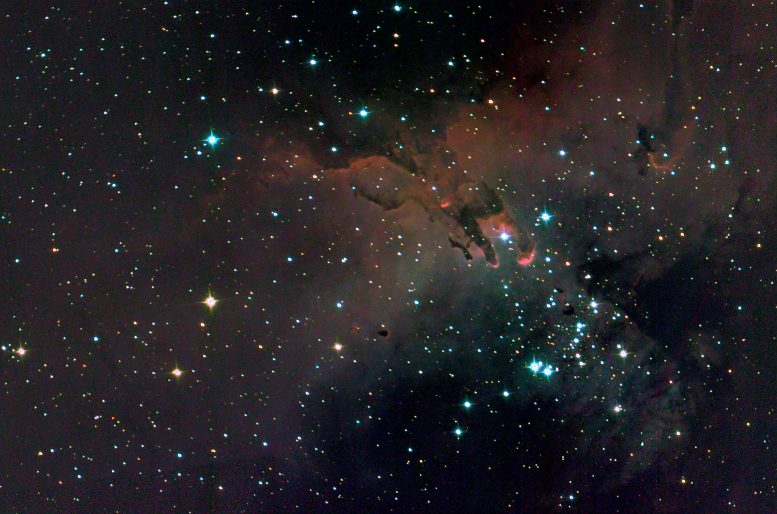
A SuperBIT optical and ultraviolet composite image of the ‘Pillars of Creation’, trunks of gas and dust in the Eagle Nebula, 7,000 light years away in the direction of the constellation of Serpens. Credit: SuperBIT team, from Romualdez et al. (2018) SPIE 10702
Durham, Toronto, and Princeton Universities have teamed up with NASA and the Canadian Space Agency to build a new kind of astronomical telescope. SuperBIT flies above 99.5% of the Earth’s atmosphere, carried by a helium balloon the size of a football stadium. The telescope will make its operational debut next April and when deployed should obtain high-resolution images rivaling those of the Hubble Space Telescope. Mohamed Shaaban, a PhD student at the University of Toronto, will describe SuperBIT in his talk tomorrow (Wednesday, July 21, 2021) at the online RAS National Astronomy Meeting (NAM 2021).
Light from a distant galaxy can travel for billions of years to reach our telescopes. In the final fraction of a second, the light has to pass through the Earth’s swirling, turbulent atmosphere. Our view of the universe becomes blurred. Observatories on the ground are built at high altitude sites to overcome some of this, but until now only placing a telescope in space escapes the effect of the atmosphere.
The Superpressure Balloon-borne Imaging Telescope (or SuperBIT) has a 0.5-meter (1.6-foot) diameter mirror and is carried to 40km (25 mi) altitude by a helium balloon with a volume of 532,000 cubic meters (140 million gallon), about the size of a football stadium.
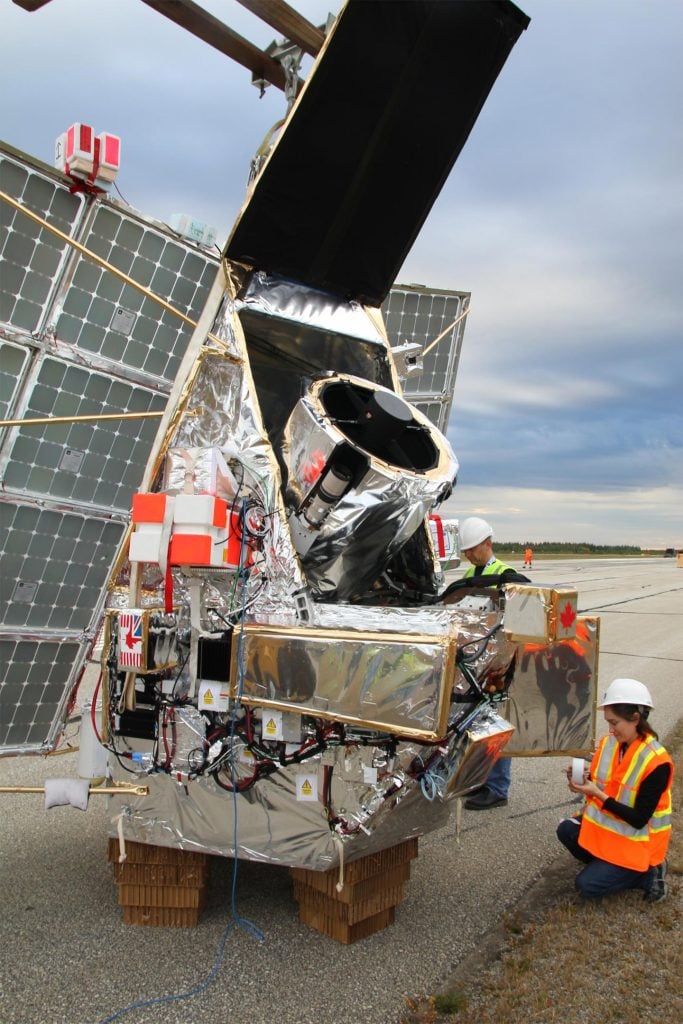
SuperBIT’s final preparations for launch from Timmins Stratospheric Balloon Base Canada, in September 2019. Credit: Steven Benton, Princeton University
Its final test flight in 2019 demonstrated extraordinary pointing stability, with a variation of less than one thirty-six thousandth of a degree for more than an hour. This should enable a telescope to obtain images as sharp as those from the Hubble Space Telescope.
Nobody has done this before, not only because it is exceedingly difficult, but also because balloons could stay aloft for only a few nights: too short for an ambitious experiment. However, NASA recently developed ‘superpressure’ balloons able to contain helium for months. SuperBIT is scheduled to launch on the next long-duration balloon, from Wanaka, New Zealand, in April. Carried by seasonally stable winds, it will circumnavigate the Earth several times – imaging the sky all night, then using solar panels to recharge its batteries during the day.
With a budget for construction and operation for the first telescope of US$5 million (£3.62 million), SuperBIT costs almost 1,000 times less than a similar satellite. Not only are balloons cheaper than rocket fuel, but the ability to return the payload to Earth and relaunch it means that its design has been tweaked and improved over several test flights. Satellites must work first time, so typically have (phenomenally expensive) redundancy, and decade-old technology that had to be space-qualified by the previous mission. Modern digital cameras improve every year – so the development team bought the cutting-edge camera for SuperBIT’s latest test flight a few weeks before launch. This space telescope will continue to be upgradable, or have new instruments on every future flight.
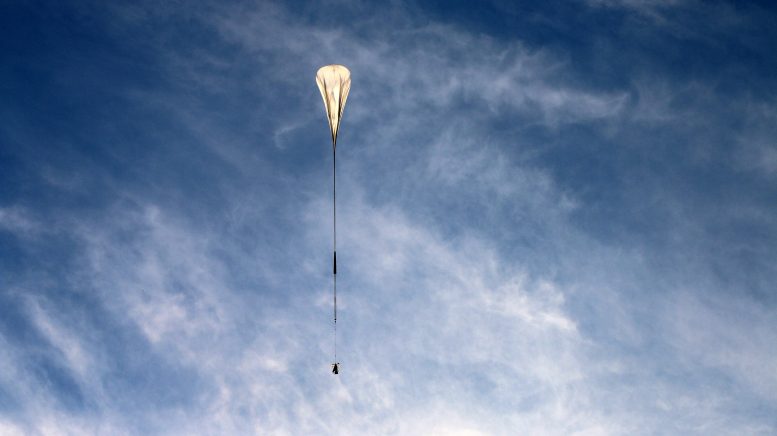
The SuperBIT balloon in flight, above NASA’s Columbia Scientific Balloon Facility, Texas, in June 2016. Credit: Richard Massey / Durham University
In the longer term, the Hubble Space Telescope will not be repaired again when it inevitably fails. For 20 years after that, ESA/NASA missions will enable imaging only at infrared wavelengths (like the James Webb Space Telescope due to launch this autumn), or a single optical band (like the Euclid Observatory due to launch next year).
By then SuperBIT will be the only facility in the world capable of high-resolution multicolor optical and ultraviolet observations. The team already has funding to design an upgrade from SuperBIT’s 0.5-meter aperture telescope to 1.5 meters or 5 feet (the maximum carrying capacity of the balloon is a telescope with a mirror about 2 meters or 6.6 feet across). Boosting light gathering power tenfold, combined with its wider angle lens and more megapixels, will make this larger instrument even better than Hubble. The cheap cost even makes it possible to have a fleet of space telescopes offering time to astronomers around the world.
“New balloon technology makes visiting space cheap, easy, and environmentally friendly,” said Shaaban. “SuperBIT can be continually reconfigured and upgraded, but its first mission will watch the largest particle accelerators in the Universe: collisions between clusters of galaxies.”
The science goal for the 2022 flight is to measure the properties of dark matter particles. Although dark matter is invisible, astronomers map the way it bends rays of light, a technique known as gravitational lensing. SuperBIT will test whether dark matter slows down during collisions. No particle colliders on Earth can accelerate dark matter, but this is a key signature predicted by theories that might explain recent observations of weirdly behaving muons.
“Cavemen could smash rocks together, to see what they’re made of,” added Prof. Richard Massey of Durham University. “SuperBIT is looking for the crunch of dark matter. It’s the same experiment, you just need a space telescope to see it.”
Meeting: Royal Astronomical Society National Astronomy Meeting

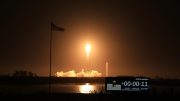

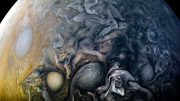
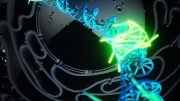

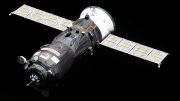
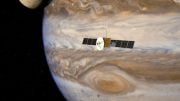

How is the team ensuring it has a long-term, affordable supply of helium? My understanding is that practically-available sources of helium (e.g. the naturally-formed underground pockets in Texas) are dwindling.
An 18 inch telescope can in no way “rival the Hubble telescope”, which is in orbit and has an aperture of more than 9 feet. Physics does not support your headline. Use a little common sense, please.
LOL. Try reading the article:
The team already has funding to design an upgrade from SuperBIT’s 0.5 meter aperture telescope to 1.5 meters (the maximum carrying capacity of the balloon is a telescope with a mirror about 2 metres across). Boosting light gathering power tenfold, combined with its wider angle lens and more megapixels, will make this larger instrument even better than Hubble.
According to Paul Smeulders – read his paper “On the Nature of Dark Matter” – this experiment is unlikely to find anything.
Paul Smeulders – a neighbour of mine – is a retired particle physicist who noticed that the speed of light is measured in terms of its own wavelength – a circular measurement that prevents you from measuring or noticing any change in the speed of light over time. Paul thinks that the speed of light is related to the density of space time – and that the size of particles is too.
So …
At the beginning of the Big Bang the speed of light was extremely high. It has been slowing down ever since. That idea alone removes the need to invent “dark energy”. The universe is NOT accelerating apart.
And …
Space time is very highly concentrated in black holes … hugely increasing the speed of light within them … and the size of the particles within – ENORMOUSLY increasing their size. So, dark matter is made up of the particles within a black hole that virtually (under the Heisenberg uncertainty principle) are the size of a galaxy (an idea you may have difficulty accepting – but the proof is in the pudding – the measurements showing the quantity and distribution of “dark matter”) … we experience the gravitational effect of “dark matter” but nothing else – the dark matter is “virtually” around us as we speak, but so diffuse that we do not notice it, and cannot measure it … yet. The distribution of dark matter in our galaxy is not uniform – it is denser nearer the centre – and Paul says that the distribution matches the density of different kinds of particles within the black hole – lighter particles being bigger. Another thing to realise is that 80% of the matter in our galaxy – in most galaxies – is already in black holes.
All this suggests that the universe is HUGELY older than we think. When all the matter in the universe is finally back in a single black hole – you have the starting condition for the whole business to recycle!
So … a very simple idea … a single idea … gets rid of dark energy and explains dark matter.
Its simplicity answers a whole lot of unanswered questions – and it is very easy to check – the ideas are so simple – Paul has written about 4 papers in the last 10 years – starting with “Why the Speed of Light is not a Constant” in 2012.
Paul says that his idea does not require any other “law of nature” to be altered. His idea – the physics implications of it – also work on particles – Paul is an expert in quantum mechanics – he was an important part of the JET Nuclear Fusion project in Culham in the UK in the 1980s.
Somebody give Paul Smeulders a Noble Prize before he snuffs it – he is 78!